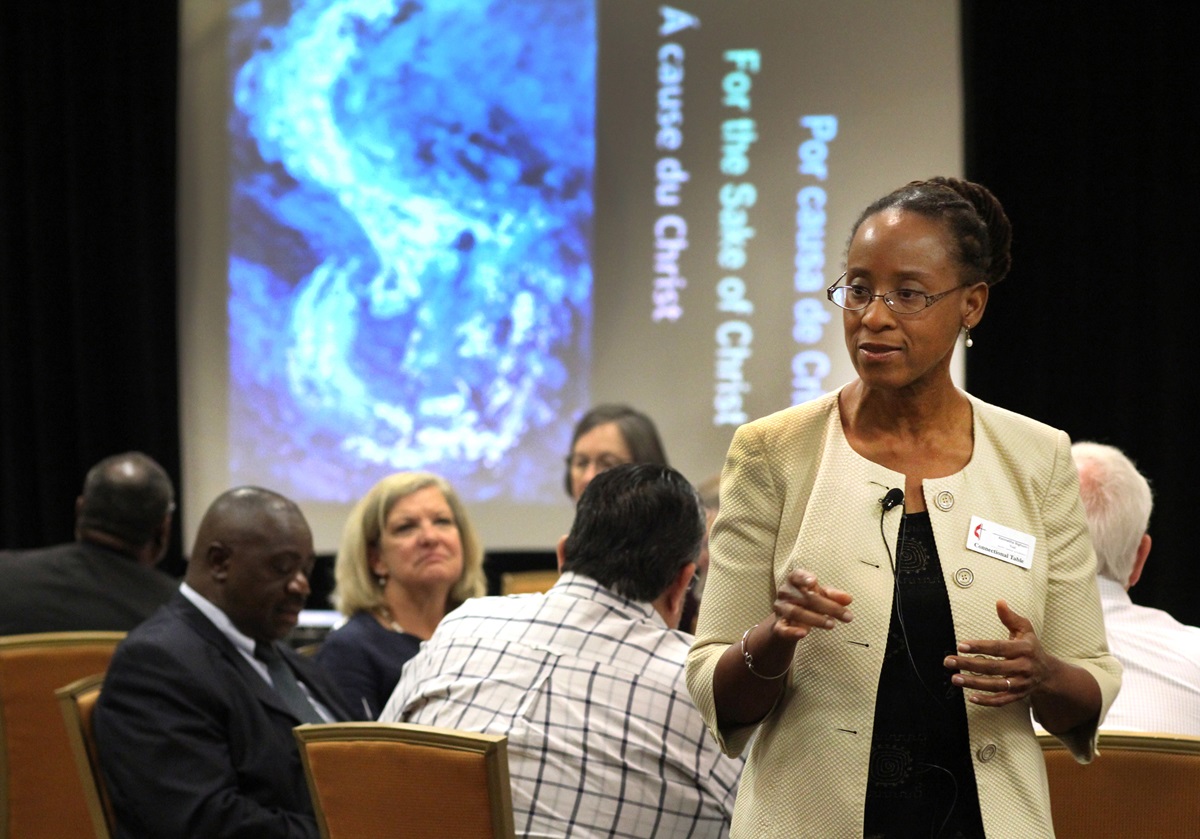The United Methodist group responsible for allocating most of the general church’s budget has recommended how to slice up a much smaller financial pie.
Under the proposal, not all ministries will bear the brunt equally of planned budget cuts scheduled to start in 2021, and one fund will see a substantial increase.
The Connectional Table Allocations Team released a 76-page report on Jan. 29 outlining its recommendations for how to divide $361.6 million — about a 23 percent drop from the current budget.
“This report has been a collaborative effort that has been grounded in deep listening and prayer,” says the Rev. Kennetha J. Bigham-Tsai, the Connectional Table’s top executive, in a statement. “I am deeply grateful to the members of the Allocations Team, and to CT and agency staff who have brought the best of themselves to this process.”
The team's report is not the final word. In April, the recommendations will next go before the full Connectional Table and the board of the General Council on Finance and Administration, the denomination’s finance agency. Those two bodies, which jointly develop the general church budget, may alter the recommendations.
Ultimately, General Conference — the denomination’s multinational legislative assembly — will decide the size and allocation of the 2021-24 denominational budget when it meets in 2020.
The Book of Discipline, the denomination’s policy book, gives the Connectional Table responsibility for allocating general church giving among five apportioned funds.
Those funds include the Ministerial Education Fund, which supports United Methodist seminaries and clergy development; the Black College Fund, which supports historically black church-affiliated schools; the Africa University Fund; and the Interdenominational Cooperation Fund, which supports ecumenical work.
The largest is the World Service Fund, which supports the work of eight general church agencies, the Connectional Table itself and a contingency fund.
Over the past three months, the allocations team has met with agency leaders and fund administrators in determining how to allot a budget that is nearly $106 million less than the current one. Agencies and other church organizations also have been looking at what the budget cuts could mean for their ministries.
From the beginning, the Connectional Table and finance agency board have stated that they likely would not allocate church apportionments the same way as they have done historically, meaning agencies and various general funds should not expect to get the same portion of financial pie.
A big concern for the allocations team, the report said, was making sure cuts were not so deep to stop the work of the denomination’s smallest agencies and six national plans for ethnic ministries.
With that in mind, the team recommends that allocations for the Commissions on the Status and Role of Women, Religion and Race and United Methodist Men and the national plans remain fairly stable.
The most dramatic change the team recommends is cutting the allocation for the Interdenominational Cooperation Fund by 88 percent — reducing its apportionment from about $8 million currently to $1 million in 2021-24.
The fund disburses grants to ecumenical organizations such as the World Council of Churches, the Pan Methodist Commission, the National Council of Churches and the World Methodist Council. However, according to the team’s report, the fund by the end of 2017 had accumulated reserves four times its 2017 expenses. In addition, the team projected the fund’s reserve levels would grow by another $600,000 by the end of 2018.
How we got here
In August, the board of the General Council on Finance and Administration unanimously approved changes in the formula used in calculating U.S. apportionments — the requested giving from U.S. annual conferences.
The board made the changes based on the recommendations of the Apportionment Sustainability Task Force, which has been examining the ramifications of long-term trends on the denomination’s financial future.
The task force focused on the denomination’s shrinking worship attendance and membership in the United States. While the multinational denomination is growing overall, U.S. United Methodists still provide more than 90 percent of the funding for general church operations worldwide.
The goal is to keep more money in local churches, but that’s not guaranteed because each conference sets its own formula for the apportionments it requests of its congregations.
In November, despite a request from the Connectional Table to reconsider, the finance agency board pressed ahead with plans to reduce requested church giving from annual conferences.
General Conference, the denomination’s top lawmaking body, will have final say on the size and allocation of the denominational budget at its 2020 session.
Based on current estimates, the 2020 General Conference is looking at a proposed general church budget of $498.65 million for the years 2021-24.
“When funds accumulate and grow over a long period of time, it is prudent to redirect those funds to missional areas where they are needed and will be used,” the report said.
The next biggest cut recommended is a 37 percent decrease for United Methodist Communications — dropping its allocation from about $71.6 million to $45 million. The agency includes United Methodist News Service.
United Methodist Communications’ board-designated and undesignated assets equal 194 percent of the agency’s expenses, according to the report. Of that, $20 million is available in one year.
“This change in allocation for UMCom recognizes that its core mission can be sustained with a more accelerated right-sizing of its reserves or other resources,” the report said. It also minimizes budgetary impact on other agencies and funds.
Under the team’s recommendations, all of the denomination’s education funds will see cuts. The recommendations decrease the Ministerial Education Fund by 31 percent, the Black College Fund by 15 percent and the pan-African Africa University Fund by 15 percent.
The cut to the Ministerial Education Fund also will affect the amount conferences retain for their educational programming such as local pastor licensing.
“This recommended reduction in MEF should spur a needed conversation about whether or not we can continue to support 13 seminaries and all of our current licensing schools given declining resources,” the report said.
The team also proposes curtailing the Central Conference Theological Fund by 30 percent and the Young Clergy Initiative by 28 percent. General Conference established both funds in 2012 to help nurture the clergy vocation. Central conferences are church regions in Africa, Europe and the Philippines.
Under the team’s recommendation, the Boards of Global Ministries, Church and Society, and Higher Education and Ministry each will see their allocations reduced by 20 percent. Discipleship Ministries, which has the lowest percentage of net assets compared to expenses, will see a 15 percent cut.
The one area where the Connectional Table team plans a substantial increase is the World Service Contingency Fund, which is used for new programs that address unanticipated needs. For instance, the contingency fund in recent years has helped support work of the denomination’s Immigration Task Force.
The team recommends boosting the fund from less than $500,000 currently to more than $8.9 million in the 2021-24 budget — a jump of more than 1,800 percent. The team had originally proposed a 3,000 percent increase, but revised it after receiving feedback during the budget process.
“Increasing this fund will give the connection greater opportunities to support innovation that addresses emerging needs,” the report said. “At a time of great change, this fund also can give our connection the ‘imaginative capacity’ to adapt, dream and develop the ministries that will lead us into the future.”
Bigham-Tsai told United Methodist News Service that agencies facing substantial budget cuts might turn to the contingency fund for collaborative ministry.
In addition to Bigham-Tsai, the Allocations Team included Nordic and Baltic Area Bishop Christian Alsted, Connection Table chair, and Connectional Table members Dave Nuckols and the Revs. Amy Coles, Brad Brady and Lyssette Perez. Bill Brownson, West Ohio Conference treasurer, served as a consultant.
"I am impressed by the ministry and stewardship of the agencies and funds we have been in conversation with in this process," Alsted said, "and with our recommendations we wish to ensure that they will be able to maintain their missional capacity and impact. On the allocations team we have done our utmost to make our recommendations based on the information we have obtained, and we have prayerfully let values and missional priorities guide our work."
The team’s report acknowledged the tough times ahead.
“Each of us on the allocations team has been painfully aware of the significant changes that are ahead, of the important ministry that could be lost, the lives that could be upended and the anxiety that this very process is causing.”
Hahn is a multimedia news reporter for United Methodist News Service. Contact her at (615) 742-5470 or newsdesk@umcom.org. To read more United Methodist news, subscribe to the free Daily or Weekly Digests.
Like what you're reading? Support the ministry of UM News! Your support ensures the latest denominational news, dynamic stories and informative articles will continue to connect our global community. Make a tax-deductible donation at ResourceUMC.org/GiveUMCom.




